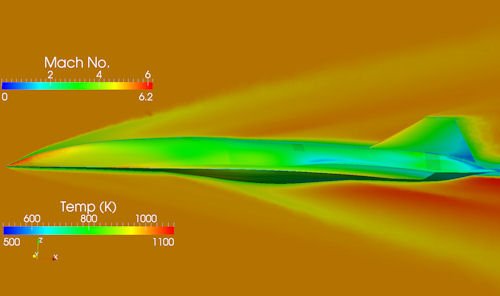Flying to the Extremes with Realistic Simulation
Latest News
November 14, 2013
 Dear Desktop Engineering Reader:
Dear Desktop Engineering Reader:
The spring of 1961 was a mesmerizing time for speed record fans. Within three months, Yuri Gagarin, Alan Shepard, and Richard White crossed over Mach 5, and the allure of hypersonic flight ” say, Mach 5.5 or faster “grabbed the popular imagination. “LA to NY in less than an hour by 1990” was a typical bit of conventional wisdom hyperventilating. Only it turned out that hypersonic flight was not as easy as slapping some wings on a rocket. Hypersonic speeds create an extreme operating environment that pile on complex phenomena like high temperatures, large temperature gradients, transient heating, and internal and external acoustic loads.
 |
Today’s Check it Out link takes you to a pair of fascinating presentations on hypersonic vehicle research. Part 1 is a 22-page technical paper titled “Multiphysics Simulations of Representative Hypersonic Vehicle Structures.” It was written by Eric Blades and three of his colleagues at ATA Engineering, an engineering consultancy based in San Diego. Part 2 is a 25-minute video recording of the same name. Recorded last spring the at the 2013 SIMULIA Community Conference, the video features Blades outlining and demonstrating some of his company’s research into a pair of panels for a hypersonic vehicle.
The gist of it is that the work at ATA Engineering is part of an overall goal to someday have reusable hypersonic vehicle designs. That means vehicles with durable structures capable of extended operation under the extreme thermal, acoustic, and mechanical loads of hypersonic flight.
To that end, Blades and his team are using simulation to optimize two panel designs near the aft end of a hypersonic vehicle. Their approach has two parts: Coupled quasi-static analyses and dynamic aerothermoelastic analyses. Their objective is to discover, better define, and document the inadequacies in the current methods used to analyze and predict the life of structures in the hot hypersonic environment. ATA Engineering hopes to develop a multiphysics coupled analysis capability for hypersonic vehicle structures since none really exists today.
The tools used in the research are Loci/CHEM for CFD (computational fluid dynamics) and Dassault SIMULIA’s Abaqus/Standard for structural modeling. Dassault SIMULIA’s Co-Simulation Engine handles the coupling between the Loci/CHEM and Abaqus. Loci/CHEM may not be familiar to you. It’s described as a Reynolds-averaged Navier-Stokes finite-volume flow solver for arbitrary polyhedra developed by Dr. Edward Luke at Mississippi State University. It uses density-based algorithms and high-resolution approximate Riemann solvers to solve finite-rate, chemically reacting viscous turbulent flows.
The paper describes ATA Engineering’s research, including the historical underpinnings of this line of study. It is richly illustrated with some 19 color images and three tables. Acknowledgements and reference works are provided.
After outlining ATA Engineering’s technical approach, the authors describe their hypersonic fluid-thermal validation investigation in detail. This is followed by a thorough explanation of the hypersonic flight panel simulation. In the final third of the paper, the authors provide more granular details of the CFD and structural models as well as how the multiphysics simulations were organized.
Mr. Blades’ presentation at the SIMULIA Community Conference is an abridged but not devitalized version of the paper. He offers a few more background details on the evolution of hypersonic research and the insights Abaqus helped uncover. It is interesting to compare and contrast the paper and video, especially in the choices of images used in the recorded session.
I found the video the more accessible of the two offerings since Blades speaks more informally as one engineer to another. But each is well worth your time whether or not hypersonic studies are part of your line of work. ATA Engineering’s technical paper and Eric Blades’ presentation of the paper at the 2013 SIMULIA Community Conference are available from today’s Check it Out link. Registration is required, and access is immediate. This is simply fascinating stuff.
Thanks, Pal. – Lockwood
Anthony J. Lockwood
Editor at Large, Desktop Engineering
Subscribe to our FREE magazine, FREE email newsletters or both!
Latest News
About the Author
Anthony J. Lockwood is Digital Engineering’s founding editor. He is now retired. Contact him via [email protected].
Follow DE





